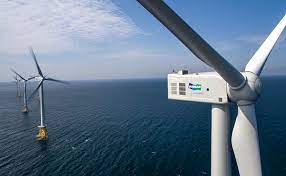An upcoming offshore wind farm is planned to be constructed in the sea east of Ulsan in South Korea and is expected to take over from United Kingdom’s Hornsea 1 as the world’s largest offshore wind farm, a wind farm that currently generated 1,218 MW of power and is operated with 174 turbines. South Korea has pledged to be carbon neutral by 2050 and in efforts to achieve this, they have set out to construct a US$32 billion wind farm.
Also Read: South Korea inches closer to floating nuclear power plants.
February 2021
In early 2021, Moon Jae-in, South Korea’s president gave the official announcement for the planned construction of the 8.2 GW offshore wind farm in Sinan, South Jeolla Province at a set budget of US$43.2 billion. This is part of the country’s “Green New Deal” for making it a carbon-neutral state. He also announced that it would create 120,000 jobs. The plant is said to be the equivalent of six nuclear power stations and has been expected to be completed by 2030 making South Korea one of the top five nations when it comes to offshore wind power generation.
May 2021
The president’s administration announces that they will invest US$32.1 billion into the construction of the wind farm and will expect public companies such as Korea National Oil Corporation and Korea East-West Power Co Ltd to take part in the development of local floating wind projects. The plan is also seemingly changed from constructing an 8.2 GW plant to a 6 GW plant but will still maintain its status as the world’s largest offshore wind farm once completed and will generate enough electricity to power 5.76 million households. As of 2020, 40% of South Korea’s electricity came from coal-fired power plants, followed by gas-fired units providing around 26%. Nuclear energy supplies around 25% and renewables account for most of the remainder. There are 24 nuclear power plants in the country, with most of them located at two complexes in its densely populated southeastern region.

